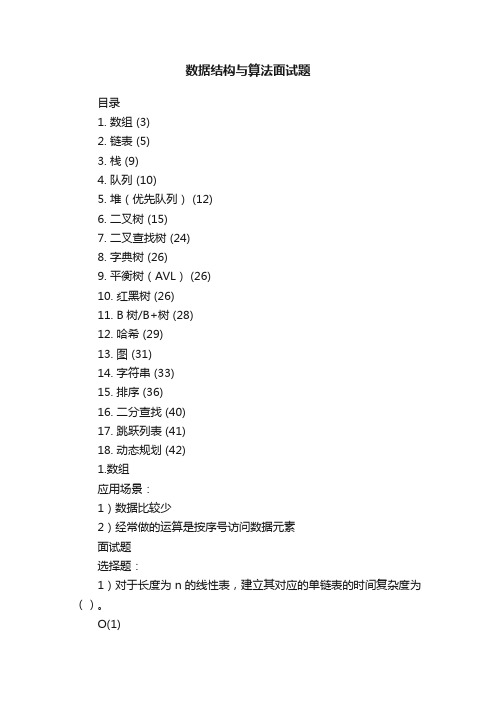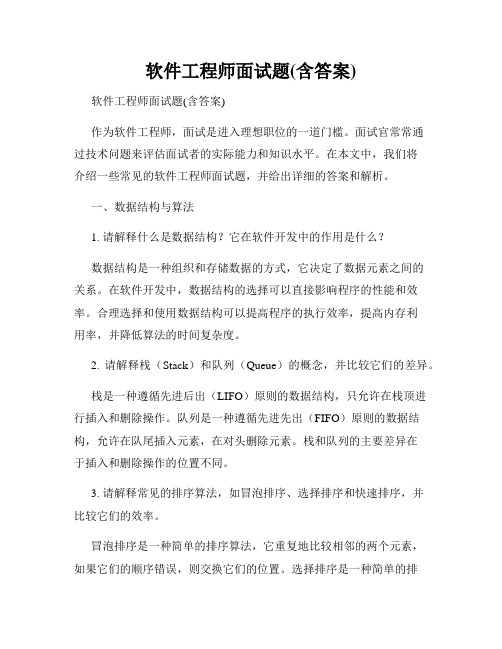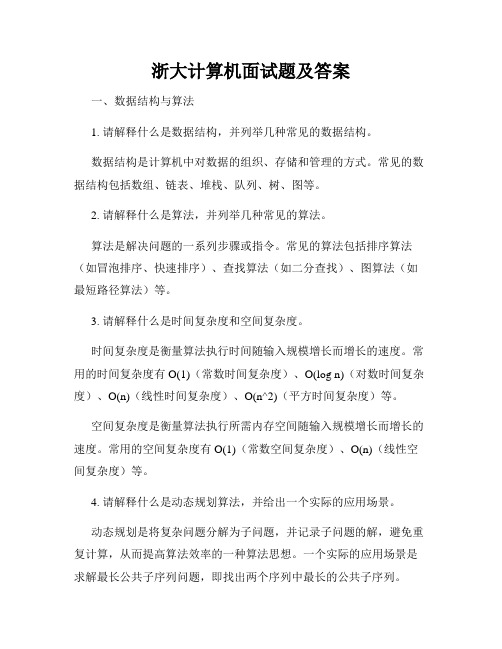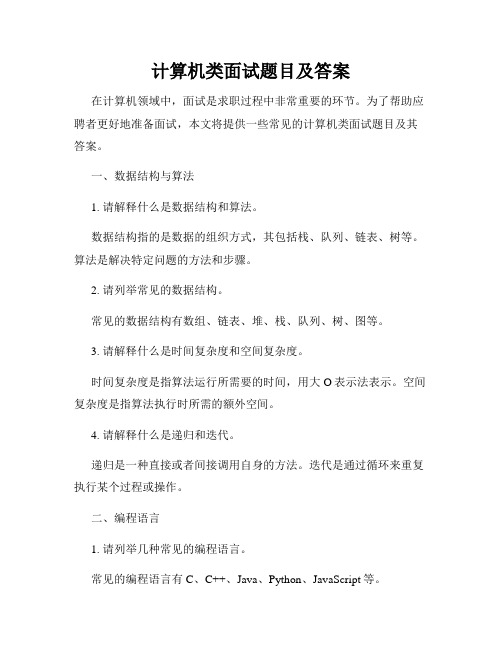数据结构与算法面试题集锦
php数据结构面试题及答案(3篇)

第1篇一、选择题1. 问题:在PHP中,以下哪个数据结构允许你以任意顺序存储元素?- A. 数组- B. 队列- C. 栈- D. 链表答案:A. 数组解析:在PHP中,数组是一种非常灵活的数据结构,它允许你以任意顺序存储元素。
每个元素可以通过一个键来访问,这个键可以是数字或者字符串。
2. 问题:以下哪个函数可以用来检查一个PHP数组是否为关联数组?- A. is_array()- B. array_keys()- C. is_associative()- D. array_is_associative()答案:D. array_is_associative()解析:PHP 7.1.0引入了`array_is_associative()`函数,该函数可以用来检查一个数组是否为关联数组。
如果是关联数组,返回`true`;如果是索引数组,返回`false`。
3. 问题:以下哪个PHP函数可以用来检查一个值是否在数组中?- A. in_array()- B. array_key_exists()- C. isset()- D. array_search()答案:A. in_array()解析:`in_array()`函数用来检查一个值是否存在于数组中。
它接受两个参数:要查找的值和要检查的数组。
二、填空题1. 问题:在PHP中,使用`[]`可以创建一个______数组。
- 答案:索引数组2. 问题:在PHP中,使用`array()`函数可以创建一个______数组。
- 答案:关联数组3. 问题:在PHP中,要遍历一个关联数组,可以使用______循环。
- 答案:foreach三、简答题1. 问题:解释PHP中的`isset()`和`empty()`函数的区别。
答案:- `isset()`函数用于检查一个变量是否已经设置并且不为`null`。
如果变量已设置且不为`null`,则`isset()`返回`true`。
程序员面试题库及答案

程序员面试题库及答案在程序员求职的过程中,面试是一个非常重要的环节。
而为了更好地准备面试,掌握程序员面试题库及答案是至关重要的。
下面将为你提供一份程序员面试题库及答案,帮助你在面试中更好地展现自己的技能和知识。
一、数据结构与算法1. 什么是栈?请写出栈的基本操作。
答案:栈是一种具有后进先出(Last In First Out,简称LIFO)特点的数据结构。
栈的基本操作包括入栈(push)、出栈(pop)、获取栈顶元素(top)以及判断栈是否为空(isEmpty)。
2. 什么是队列?请写出队列的基本操作。
答案:队列是一种具有先进先出(First In First Out,简称FIFO)特点的数据结构。
队列的基本操作包括入队(enqueue)、出队(dequeue)、获取队头元素(front)以及判断队列是否为空(isEmpty)。
二、编程语言1. 请简要介绍一下面向对象编程(Object-Oriented Programming, OOP)的概念及特点。
答案:面向对象编程是一种编程范式,它的核心思想是将现实世界的事物抽象成对象,并通过对象之间的交互来完成任务。
面向对象编程的特点包括封装、继承和多态。
2. 请列举几个面向对象编程中常用的设计模式,并简要说明其应用场景。
答案:常用的面向对象编程设计模式包括工厂模式、单例模式和观察者模式。
- 工厂模式用于创建对象,通过工厂类的统一接口来实现对象的创建和初始化。
- 单例模式用于限制某个类只能存在一个实例,常用于全局资源共享或者对象唯一性的场景。
- 观察者模式用于实现对象之间的一对多依赖关系,当一个对象发生改变时,所有依赖它的对象都会得到通知。
三、数据库1. 什么是关系型数据库(Relational Database)?答案:关系型数据库是一种以表格的形式组织数据的数据库系统,通过表之间的关系来建立数据之间的联系。
关系型数据库使用结构化查询语言(Structured Query Language, SQL)进行数据的操作和查询。
数据结构和算法面试题

数据结构和算法面试题以下是一些常见的数据结构和算法面试题:1. 数组- 如何在一个已排序的数组中查找指定的元素?- 如何在一个无序的数组中查找指定的元素?- 如何找到一个数组中的最大元素?- 如何找到一个数组中的第k大元素?2. 链表- 如何反转一个链表?- 如何找到一个链表的中间节点?- 如何检测一个链表是否有环?- 如何合并两个有序链表?- 如何删除链表中的重复节点?3. 栈和队列- 如何用栈来实现队列操作?- 如何用队列来实现栈操作?- 如何实现一个最小值栈,即在常数时间内获取栈中的最小值?- 如何实现一个最小值队列,即在常数时间内获取队列中的最小值?- 如何用栈来判断一个字符串中的括号是否匹配?4. 树和图- 如何遍历二叉树(前序、中序、后序、层次遍历)?- 如何判断两个二叉树是否相同?- 如何判断一个二叉树是否为二叉搜索树?- 如何找到二叉树中的最大路径和?- 如何判断一个有向图中是否有环?5. 哈希表- 如何实现一个简单的哈希表?- 如何解决哈希冲突?- 如何找到一个数组中两个数的和为给定值的索引?- 如何找到一个数组中三个数的和为给定值的索引?6. 排序和搜索- 如何实现快速排序?- 如何实现归并排序?- 如何实现二分查找?- 如何在一个有序矩阵中查找指定的元素?7. 动态规划- 如何在一个字符串中找到一个最长的回文子串?- 如何实现一个背包问题的动态规划解法?- 如何计算一个整数的斐波那契数列?- 如何计算一个矩阵的最短路径和?以上只是一些常见的面试题,实际面试中可能会有更具体和具有挑战性的问题。
在准备面试时,建议根据自己的经验和需要,补充和练习相关的算法和数据结构。
数据结构面试题(含答案)

数据结构面试题(含答案)1、栈与队列得共同特点就是(只允许在端点处插入与删除元素)、4两得用采常通栈ﻫ种存储结构就是(线性存储结构与链表存储结构)、5)D(是就得确正述叙得栈于关列下ﻫA、栈就是非线性结构B、栈就是一种树状结构C、栈具有先进先出得特征D、栈有后进先出得特征6、链表不具有得特点就是(B)A、不必事先估计存储空间B、可随机访问任一元素C、插入删除不需要移动元素D、所需空间与线性表长度成正比、7线示表表链用ﻫ性表得优点就是(便于插入与删除操作)8、在单链表中,增加头结点得目得就是(方便运算得实现)、9是就点优要主得表链环循ﻫ(从表中任一结点出发都能访问到整个链表)、01a,2a,1a(=L表性线ﻫ3,……ai,……an),下列说法正确得就是(D)A、每个元素都有一个直接前件与直接后件B、线性表中至少要有一个元素C、表中诸元素得排列顺序必须就是由小到大或由大到小D、除第一个与最后一个元素外,其余每个元素都有一个且只有一个直接前件与直接后件、11)D(址地得元单储存用可中存内求要,时构结储存式链用采若表性线ﻫA、必须就是连续得B、部分地址必须就是连续得C、一定就是不连续得D、连续不连续都可以12、线性表得顺序存储结构与线性表得链式存储结构分别就是(随机存取得存储结构、顺序存取得存储结构)13、树就是结点得集合,它得根结点数目就是(有且只有1)、41树叉二满得5为度深在ﻫ中,叶子结点得个数为(31)、51、)态形种5(有树叉61树叉二棵一设ﻫ中有3个叶子结点,有8个度为1得结二得点结个3有具ﻫ点,则该二叉树中总得结点数为(13)、71知已ﻫ二叉树后序遍历序列就是dabec,中序遍历序列就是debac,它得前序遍历序列就是(cedba)18、已知一棵二叉树前序遍历与中序遍历分别为ABDEGCFH与DBGEACHF,则该二叉树得后序遍历为(DGEBHFCA)、91是就序顺问访历遍序前得树叉二某若ﻫabdgcefh,中序遍历访问顺序就是dgbaechf,则其后序遍历得结点访问顺序就是(gdbehfca)20、数据库保护分为:安全性控制、完整性控制、并发性控制与数据得恢复。
22道数据结构算法面试题

微软的22道数据结构算法面试题(含答案)1、反转一个链表。
循环算法。
1 List reverse(List l) {2 if(!l) return l;3 list cur = l.next;4 list pre = l;5 list tmp;6 pre.next = null;7 while ( cur ) {8 tmp = cur;9 cur = cur.next;10 tmp.next = pre;11 pre = tmp;12 }13 return tmp;14 }2、反转一个链表。
递归算法。
1 List resverse(list l) {2 if(!l || !l.next) return l;34 List n = reverse(l.next);5 l.next.next = l;6 l.next=null;7 }8 return n;9 }3、广度优先遍历二叉树。
1 void BST(Tree t) {2 Queue q = new Queue();3 q.enque(t);4 Tree t = q.deque();5 while(t) {6 System.out.println(t.value);7 q.enque(t.left);9 t = q.deque();10 }11 }----------------------1class Node {2 Tree t;3 Node next;4 }5class Queue {6 Node head;7 Node tail;8 public void enque(Tree t){9 Node n = new Node();10 n.t = t;11 if(!tail){12 tail = head = n;13 } else {14 tail.next = n;15 tail = n;16 }17 }18 public Tree deque() {19 if (!head) {20 return null;21 } else {22 Node n = head;23 head = head.next;24 return n.t;25 }26}4、输出一个字符串所有排列。
经典数据结构面试题(含答案)

经典数据结构面试题(含答案)1. 什么是数据结构?数据结构是计算机存储、组织数据的方式,它能够更有效地存储数据,以便于进行数据检索和修改。
2. 什么是线性表?线性表是一种基本的数据结构,由一组数据元素组成,其中每个元素都有一个前驱和一个后继,除了第一个元素没有前驱,一个元素没有后继。
3. 什么是栈?栈是一种后进先出(LIFO)的数据结构,它允许在一端进行插入和删除操作,通常称为栈顶。
4. 什么是队列?队列是一种先进先出(FIFO)的数据结构,它允许在一端进行插入操作,在另一端进行删除操作,通常称为队头和队尾。
5. 什么是链表?链表是一种由节点组成的数据结构,每个节点包含数据和指向下一个节点的指针。
链表可以分为单向链表、双向链表和循环链表。
6. 什么是树?树是一种非线性数据结构,由节点组成,每个节点有零个或多个子节点。
树可以分为二叉树、平衡树、B树等。
7. 什么是图?图是一种由节点和边组成的数据结构,节点称为顶点,边表示顶点之间的关系。
图可以分为有向图和无向图。
8. 什么是排序算法?排序算法是一种对数据进行排序的方法,常见的排序算法有冒泡排序、选择排序、插入排序、快速排序、归并排序等。
9. 什么是哈希表?哈希表是一种基于哈希函数的数据结构,它通过哈希函数将键值映射到表中一个位置来快速检索数据。
10. 什么是动态规划?动态规划是一种在数学、管理科学、计算机科学、经济学和生物信息学中使用的,通过把原问题分解为相对简单的子问题的方式求解复杂问题的方法。
经典数据结构面试题(含答案)11. 什么是二叉搜索树?二叉搜索树是一种特殊的二叉树,其中每个节点的左子树只包含小于该节点的值,右子树只包含大于该节点的值。
12. 什么是平衡二叉树?平衡二叉树是一种自平衡的二叉搜索树,它通过旋转操作来保持树的平衡,使得树的高度保持在对数级别。
13. 什么是B树?B树是一种自平衡的树数据结构,它保持数据的有序性,并允许搜索、顺序访问、插入和删除的操作都在对数时间内完成。
数据结构与算法面试题

数据结构与算法面试题目录1. 数组 (3)2. 链表 (5)3. 栈 (9)4. 队列 (10)5. 堆(优先队列) (12)6. 二叉树 (15)7. 二叉查找树 (24)8. 字典树 (26)9. 平衡树(AVL) (26)10. 红黑树 (26)11. B树/B+树 (28)12. 哈希 (29)13. 图 (31)14. 字符串 (33)15. 排序 (36)16. 二分查找 (40)17. 跳跃列表 (41)18. 动态规划 (42)1.数组应用场景:1)数据比较少2)经常做的运算是按序号访问数据元素面试题选择题:1)对于长度为n的线性表,建立其对应的单链表的时间复杂度为()。
O(1)O(log2n)O(n)O(n^2)2)下列哪些不是线性表?队列栈关联数组链表3)稀疏矩阵一般的压缩存储方法有两种,即()二维数组和三维数组三元组和散列三元组和十字链表散列和十字链表4)将10阶对称矩阵压缩存储到一维数组A中,则数组A的长度最少为1004055805)设A是n*n的对称矩阵,将A的对角线及对角线上方的元素以列为主的次序存放在一维数组B[1..n(n+1)/2]中,对上述任一元素aij (1≤i,j≤n,且i≤j)在B中的位置为()i(i-1)/2+jj(j-1)/2+ij(j-1)/2+i-1i(i-1)/2+j-16)若有定义:int c[4][5],( *pc)[5];pc=c;那么,下列对数组C的元素引用正确的是( )。
pc+1* (pc+3)* (pc+1) +3* (*pc+2)问答题:1)数组和链表的区别思路:从逻辑结构上来看,数组必须实现定于固定的长度,不能适应数据动态增减的情况,即数组的大小一旦定义就不能改变。
当数据增加是,可能超过原先定义的元素的个数;当数据减少时,造成内存浪费;链表动态进行存储分配,可以适应数据动态地增减的情况,且可以方便地插入、删除数据项。
从内存存储的角度看;数组从栈中分配空间(用new则在堆上创建),对程序员方便快速,但是自由度小;链表从堆中分配空间,自由度大但是申请管理比较麻烦。
数据结构与算法面试题

应用场景:
1)数据比较少
2)经常做的运算是按序号访问数据元素
面试题
选择题:
1)对于长度为n的线性表,建立其对应的单链表的时间复杂度为()。
O(1)
O(log2n)
O(n)
O(n^2)
2)下列哪些不是线性表?
队列
栈
关联数组
链表
3)稀疏矩阵一般的压缩存储方法有两种,即()
二维数组和三维数组
三元组和散列
Node dummyHead = new Node(0);
Node p = head;
dummyHead.next = head;
//p的值不小于下一节点元素考察下一节点
while (p.next != null) {
if (p.value <= p.next.value) {
p = p.next;
面试题
选择题:
1)在一个单链表中,q的前一个节点为p,删除q所指向节点,则执行()。
delete q
q->next=p->next;delete p
p->next=q->next;delete p
p->next=q->next;delete q
delete p
q->next=p->next;delete q
q = q.next;
temp.next = q.next;
//重新连接链表注意else的过程并没有改变p指针的位置
q.next = temp;
}
}
return dummyHead.next;
}
3.
应用场景:
1)数制转换
2)括号匹配检验
架构师面试中常见的数据结构与算法题(60题)

架构师面试题 -常见的数据结构与算法 数组(共30题,含答案)1.矩阵中的⾏列数可以是不相等的,这样的说法正确吗?A.正确B.不正确2.对矩阵压缩存储是为了A.⽅便运算B.⽅便存储C.提⾼运算速度D.减少存储空间3.⼀维数组与线性表的区别是A.前者⻓度固定,后者⻓度可变B.后者⻓度固定,前者⻓度可变C.两者⻓度均固定D.两者⻓度均可变4.在以下的叙述中,正确的是A.线性表的顺序存储结构优于链表存储结构B.⼆维数组是其数据元素为线性表的线性表C.栈的操作⽅式是先进先出D.队列的操作⽅式是先进后出5.顺序存储⽅式插⼊和删除时效率太低,因此它不如链式存储⽅式好。
A.TB.F6.数组是⼀种线性结构,因此只能⽤来存储线性表A.对B.错7.设有⼀个⼆维数组A[m][n],假设A[0][0]存放位置在644(10),A[2][2]存放位置在676(10),每个元素占⼀个空间,问A[3][3](10)存放在什么位置?脚注(10)表示⽤10进制表示A.688B.678C.692D.6968.定义了⼀维int 型数组a[10] 后,下⾯错误的引⽤是A.a[0] = 1;B.a[0] = 5*2;C.a[10] = 2;D.a[1] = a[2] * a[0];9.在⼀个⻓度为n的顺序表中删除第i个元素,要移动_______个元素。
如果要在第i个元素前插⼊⼀个元素,要后移_________个元素。
A.n-i,n-i+1B.n-i+1,n-iC.n-i,n-iD.n-i+1,n-i+110.已知10*12 的⼆维数组A ,以⾏序为主序进⾏存储,每个元素占1 个存储单元,已知A[1][1] 的存储地址为420 ,则A[5][5] 的存储地址为A.470B.471C.472D.47311.取线性表的第i个元素的时间同i的⼤⼩有关。
A.TB.F12.若要定义⼀个具有5 元素的整型数组,以下错误的定义语句是A.int a[5] = {0};B.int a[] = {0, 0, 0, 0, 0};C.int a[2+3];D.int i = 5, a[i];13.⻓度为n 的⾮空顺序表,若在第i个位置插⼊新的元素X,则i的取值范围是1≤i≤n+1,需要移动的元素个数为A.iB.n-i-1C.n-iD.n-i+114.设有⼀个10阶的对称矩阵A,采⽤压缩存储⽅式,以⾏序为主存储,a11为第⼀元素,其存储地址为1,每个元素占⼀个地址空间,则a85的地址为A.13B.33C.18D.4015.设⼀维数组中有n个数组元素,则读取第i个数组元素的平均时间复杂度为A.O(n)B.O(nlog2n)C.O(1)D.O(n2)16.定义语句"double * array [8]"的含义正确的是A.array是⼀个指针,它指向⼀个数组,数组的元素时是双精度实型B.array是⼀个数组,数组的每⼀个元素是指向双精度实型数据的指针CC语⾔中不允许这样的定义语句D.以上都不对17.有⼀个⽤数组C[1..m]表示的环形队列,m为数组的⻓度。
数据结构+算法面试100题

数据结构+算法面试100题(共27页)-本页仅作为预览文档封面,使用时请删除本页-数据结构+算法面试100题~~~摘自CSDN,作者July1.把二元查找树转变成排序的双向链表(树)题目:输入一棵二元查找树,将该二元查找树转换成一个排序的双向链表。
要求不能创建任何新的结点,只调整指针的指向。
10/ /6 14/ / / /4 8 12 16转换成双向链表4=6=8=10=12=14=16。
首先我们定义的二元查找树节点的数据结构如下:struct BSTreeNode{int m_nValue; 计包含min函数的栈(栈)定义栈的数据结构,要求添加一个min函数,能够得到栈的最小元素。
要求函数min、push以及pop的时间复杂度都是O(1)。
参见C:\Users\Administrator\Desktop\demo\Stack分析:min时间复杂度要达到O(1),需要我们在栈中存储最小元素3.求子数组的最大和(数组)题目:输入一个整形数组,数组里有正数也有负数。
数组中连续的一个或多个整数组成一个子数组,每个子数组都有一个和。
求所有子数组的和的最大值。
要求时间复杂度为O(n)。
例如输入的数组为1, -2, 3, 10, -4, 7, 2, -5,和最大的子数组为3, 10, -4, 7, 2,因此输出为该子数组的和18。
分析:根据dp思想#include <>#define N 8int main(){int i, a[N] = {1, -2, 3, 10, -4, 7, 2, -5};int from[N], result[N], max;max = 0;from[0] = 0;result[0] =a[0];for (i = 1; i < N; ++i){if (result[i - 1] > 0){from[i] = from[i - 1];result[i] = a[i] + result[i - 1];}else{from[i] = i;result[i] = a[i];}if (result[i] > result[max])max = i;}printf("%d->%d: %d\n", from[max], max, result[max]);return 0;}4.在二元树中找出和为某一值的所有路径(树)题目:输入一个整数和一棵二元树。
软件工程师面试题(含答案)

软件工程师面试题(含答案)软件工程师面试题(含答案)作为软件工程师,面试是进入理想职位的一道门槛。
面试官常常通过技术问题来评估面试者的实际能力和知识水平。
在本文中,我们将介绍一些常见的软件工程师面试题,并给出详细的答案和解析。
一、数据结构与算法1. 请解释什么是数据结构?它在软件开发中的作用是什么?数据结构是一种组织和存储数据的方式,它决定了数据元素之间的关系。
在软件开发中,数据结构的选择可以直接影响程序的性能和效率。
合理选择和使用数据结构可以提高程序的执行效率,提高内存利用率,并降低算法的时间复杂度。
2. 请解释栈(Stack)和队列(Queue)的概念,并比较它们的差异。
栈是一种遵循先进后出(LIFO)原则的数据结构,只允许在栈顶进行插入和删除操作。
队列是一种遵循先进先出(FIFO)原则的数据结构,允许在队尾插入元素,在对头删除元素。
栈和队列的主要差异在于插入和删除操作的位置不同。
3. 请解释常见的排序算法,如冒泡排序、选择排序和快速排序,并比较它们的效率。
冒泡排序是一种简单的排序算法,它重复地比较相邻的两个元素,如果它们的顺序错误,则交换它们的位置。
选择排序是一种简单的排序算法,它每次选择最小的元素放到已排序序列的末尾。
快速排序是一种常用的分治法排序算法,它通过选择一个基准元素,将数据分为左右两个子序列进行递归排序。
相比于冒泡排序和选择排序,快速排序通常具有更高的效率。
二、编程语言与开发工具1. 请解释面向对象编程(OOP)的概念,并列举几种面向对象编程语言。
面向对象编程是一种编程思想,它将数据和操作数据的方法封装在一起,形成对象。
面向对象编程的核心概念包括封装、继承和多态。
常见的面向对象编程语言包括Java、C++、C#等。
2. 请解释什么是异常处理,为什么在开发过程中需要使用异常处理机制?异常处理是一种用于处理程序错误和异常情况的机制。
在开发过程中,不可避免会出现各种意外情况,如文件不存在、网络连接断开等。
java数据结构算法面试题

java数据结构算法面试题面试对于求职者来说是一个重要的环节,尤其是对于计算机专业的求职者来说,数据结构和算法是面试中经常涉及的重要话题。
掌握Java数据结构和算法面试题,对于成功通过面试至关重要。
本文将介绍一些常见的Java数据结构和算法面试题,并给出相应的解答。
一、数组1. 给定一个整数数组,如何找到其中的最大值和最小值?解答:可以使用遍历数组的方式比较每个元素与当前的最大值和最小值,更新最大值和最小值。
2. 给定一个整数数组,如何找到其中两个数的和等于指定的目标值?解答:可以使用两层循环遍历数组,对每对不同的数进行求和判断是否等于目标值。
二、链表1. 如何实现链表的反转?解答:可以创建一个新的链表,然后遍历原链表,将原链表的每个节点插入到新链表的头部即可。
2. 如何判断链表中是否存在环?解答:可以使用快慢指针的方式遍历链表,如果存在环,则快指针最终会追上慢指针。
三、栈和队列1. 如何使用栈实现队列?解答:可以使用两个栈,一个用于入队操作,另一个用于出队操作。
当进行出队操作时,如果出队的栈为空,则需要将入队的栈中的元素依次出栈并入队栈,然后再出队。
2. 如何使用队列实现栈?解答:可以使用两个队列,一个用于入栈操作,另一个用于出栈操作。
当进行出栈操作时,需要将入栈的队列中的元素依次出队并入出栈的队列,直到剩下一个元素,即为需要出栈的元素。
四、排序算法1. 如何实现快速排序算法?解答:快速排序算法是一种分治算法,基本思想是选择一个基准元素,将数组分成两个子数组,小于基准元素的放在左边,大于基准元素的放在右边,然后递归地对子数组进行排序。
2. 如何实现归并排序算法?解答:归并排序算法也是一种分治算法,基本思想是将数组递归地分成两个子数组,然后合并两个有序的子数组,最终得到一个有序的数组。
五、查找算法1. 如何实现二分查找算法?解答:二分查找算法是一种分而治之的思想,首先将数组按照中间元素划分为两个子数组,然后判断目标值与中间元素的大小关系,从而确定目标值在哪个子数组中,然后递归地进行查找。
浙大计算机面试题及答案

浙大计算机面试题及答案一、数据结构与算法1. 请解释什么是数据结构,并列举几种常见的数据结构。
数据结构是计算机中对数据的组织、存储和管理的方式。
常见的数据结构包括数组、链表、堆栈、队列、树、图等。
2. 请解释什么是算法,并列举几种常见的算法。
算法是解决问题的一系列步骤或指令。
常见的算法包括排序算法(如冒泡排序、快速排序)、查找算法(如二分查找)、图算法(如最短路径算法)等。
3. 请解释什么是时间复杂度和空间复杂度。
时间复杂度是衡量算法执行时间随输入规模增长而增长的速度。
常用的时间复杂度有O(1)(常数时间复杂度)、O(log n)(对数时间复杂度)、O(n)(线性时间复杂度)、O(n^2)(平方时间复杂度)等。
空间复杂度是衡量算法执行所需内存空间随输入规模增长而增长的速度。
常用的空间复杂度有O(1)(常数空间复杂度)、O(n)(线性空间复杂度)等。
4. 请解释什么是动态规划算法,并给出一个实际的应用场景。
动态规划是将复杂问题分解为子问题,并记录子问题的解,避免重复计算,从而提高算法效率的一种算法思想。
一个实际的应用场景是求解最长公共子序列问题,即找出两个序列中最长的公共子序列。
5. 请解释什么是贪心算法,并给出一个实际的应用场景。
贪心算法是一种每步选择当前最优解的算法思想。
一个实际的应用场景是求解零钱找零问题,即用最少数量的硬币找零。
二、操作系统与网络1. 请解释什么是操作系统,并列举几种常见的操作系统。
操作系统是计算机系统的核心软件,负责管理计算机硬件资源、提供用户接口和运行应用程序等。
常见的操作系统有Windows、Linux、Unix、macOS等。
2. 请解释什么是进程和线程,并解释二者的区别。
进程是程序在操作系统中的一次执行过程,具有独立的地址空间和资源。
线程是进程的一个执行单元,多个线程共享进程的资源。
区别在于进程是独立的执行单位,而线程是进程内的执行单位。
3. 请解释什么是虚拟内存,并解释其作用。
数据结构与算法面试题

数据结构与算法面试题一、简介数据结构与算法是计算机科学中的重要概念,它们作为计算机程序设计的基础,被广泛应用于各个领域。
在面试过程中,面试官通常会提问一些关于数据结构与算法的问题,以评估面试者的编程能力和问题解决能力。
本文将介绍一些常见的数据结构与算法面试题,并提供解答思路和示例代码。
二、数组相关问题1. 反转数组给定一个数组,请将数组中的元素反转。
解答思路:可以使用两个指针,分别指向数组的头部和尾部,通过交换头尾元素的位置来实现反转。
2. 数组中的最大值和最小值给定一个数组,请找出数组中的最大值和最小值。
解答思路:遍历数组,通过逐个比较来找到最大值和最小值。
三、链表相关问题1. 链表反转给定一个链表,请将链表反转。
解答思路:可以使用三个指针,分别指向当前节点、前一个节点和后一个节点,通过修改节点的指针指向来实现链表反转。
2. 链表中环的检测给定一个链表,判断链表中是否存在环。
解答思路:使用快慢指针,快指针每次移动两个节点,慢指针每次移动一个节点,如果快指针和慢指针相遇,则说明链表中存在环。
四、栈和队列相关问题1. 有效的括号给定一个只包含括号的字符串,请判断字符串中的括号是否有效。
解答思路:使用栈来处理括号匹配问题,遍历字符串,遇到左括号则入栈,遇到右括号则出栈并判断是否匹配。
2. 用队列实现栈使用队列实现栈的功能。
解答思路:使用两个队列,一个主队列用于存储数据,一个辅助队列用于在主队列出队时保存数据。
每次入栈时直接入队主队列,出栈时将主队列的元素依次出队并入队辅助队列,直到主队列中只剩下一个元素,然后将主队列出队,再将辅助队列中的元素再依次入队主队列。
五、搜索相关问题1. 二分查找在有序数组中查找指定元素的位置。
解答思路:使用二分查找法,将数组从中间划分为两部分,判断中间元素是否等于目标元素,如果等于则返回该位置,如果大于目标元素则在左半部分继续查找,如果小于则在右半部分继续查找,直到找到目标元素或者数组被查找完。
数据结构面试题及答案

数据结构面试题及答案数据结构是计算机科学中的重要概念,广泛应用于算法设计和程序开发等领域。
在技术岗位的面试过程中,数据结构相关的面试题常常出现,考察面试者对数据结构的理解和运用能力。
本文将介绍一些常见的数据结构面试题,并附上详细答案,帮助读者更好地准备面试。
一、栈相关面试题1. 面试题:请解释什么是栈(Stack)数据结构?答案:栈是一种遵循后进先出(Last-In-First-Out,LIFO)原则的数据结构。
栈具有两个基本操作:入栈(push)和出栈(pop)。
入栈指将元素插入栈的顶部,出栈指将栈顶的元素删除。
栈的应用场景包括函数调用、表达式求值等。
2. 面试题:如何使用数组来实现栈?答案:可以使用一个整数变量top来表示栈顶的索引位置,初始值为-1。
入栈操作相当于将元素添加到数组的top+1位置,同时将top的值加1;出栈操作相当于将top位置的元素删除,同时将top的值减1。
3. 面试题:请用代码实现一个栈的基本操作。
答案:```pythonclass Stack:def __init__(self):self.stack = []def is_empty(self):return len(self.stack) == 0def push(self, item):self.stack.append(item)def pop(self):if not self.is_empty():return self.stack.pop()else:return Nonedef peek(self):if not self.is_empty():return self.stack[-1]else:return None```二、队列相关面试题1. 面试题:请解释什么是队列(Queue)数据结构?答案:队列是一种遵循先进先出(First-In-First-Out,FIFO)原则的数据结构。
队列具有两个基本操作:入队(enqueue)和出队(dequeue)。
计算机行业面试题目及答案

计算机行业面试题目及答案一、数据结构与算法1. 请解释什么是数据结构?以及常见的数据结构有哪些?数据结构是计算机存储、组织和处理数据的方式。
常见的数据结构包括数组、链表、栈、队列、树、图等。
2. 请介绍常见的排序算法,并分析它们的时间复杂度。
常见的排序算法有冒泡排序、选择排序、插入排序、快速排序、归并排序等。
其中,冒泡排序和插入排序的时间复杂度为O(n^2),选择排序的时间复杂度为O(n^2),快速排序和归并排序的时间复杂度为O(nlogn)。
3. 解释什么是动态规划?动态规划是一种解决问题的算法思想,它通常用于解决具有重叠子问题结构和最优子结构性质的问题。
通过将问题拆解成一系列子问题,并通过保存子问题的解来避免重复计算,从而提高算法的效率。
4. 请解释什么是哈希表及其应用场景。
哈希表是一种根据关键字直接访问内存存储位置的数据结构。
它通常通过哈希函数将关键字映射为内存位置,并在该位置存储对应的值。
哈希表广泛应用于查找、插入和删除操作频繁的场景,如数据库索引、缓存等。
二、操作系统与网络1. 请解释进程和线程的区别。
进程是指一个程序在执行过程中的实体,它具有独立的内存空间和系统资源。
线程是进程的执行单元,多个线程可以共享同一进程的内存空间和系统资源。
与进程相比,线程的切换开销较小,同时线程之间的通信也更加方便。
2. 请解释什么是死锁及如何避免死锁发生。
死锁是指多个进程或线程因互相等待对方持有的资源而无法继续执行的状态。
要避免死锁,可以采取以下方法:- 避免使用多个共享资源- 使用资源分级策略,按照固定的顺序获取锁- 使用超时机制,避免长时间等待资源- 引入死锁检测机制,及时检测并解决死锁问题3. 请解释什么是虚拟内存及其作用。
虚拟内存是一种操作系统的内存管理技术,它将物理内存和磁盘空间结合起来,为每个进程提供一个逻辑上连续且私有的内存空间。
虚拟内存的作用包括:- 扩大可用的内存空间,允许运行更多的进程- 提供内存保护机制,防止进程之间的相互干扰- 管理磁盘上的内存页面,提高内存的使用效率三、数据库1. 请解释什么是事务,并介绍事务的四个特性(ACID)。
数据结构与算法面试题80道

数据结构与算法面试题80道由于这些题,实在太火了。
因此,应广大网友建议要求,在此把之前已整理公布的前80题,现在,一次性分享出来。
此也算是前80题第一次集体亮相。
此些题,已有上万人,看到或见识到,若私自据为己有,必定为有知之人识破,付出代价。
因此,作者声明:本人July对以上所有任何内容和资料享有版权,转载请注明作者本人July出处。
向你的厚道致敬。
谢谢。
----------------------------------------------------------------------------------------------------------------1.把二元查找树转变成排序的双向链表题目:输入一棵二元查找树,将该二元查找树转换成一个排序的双向链表。
要求不能创立任何新的结点,只调整指针的指向。
10/ \6 14/ \ / \4 8 12 16转换成双向链表4=6=8=10=12=14=16。
首先我们定义的二元查找树节点的数据结构如下:struct BSTreeNode{int m_nValue; // value of nodeBSTreeNode *m_pLeft; // left child of nodeBSTreeNode *m_pRight; // right child of node};2.设计包含min函数的栈。
定义栈的数据结构,要求添加一个min函数,能够得到栈的最小元素。
要求函数min、push以及pop的时间复杂度都是O(1)。
3.求子数组的最大和题目:输入一个整形数组,数组里有正数也有负数。
数组中连续的一个或多个整数组成一个子数组,每个子数组都有一个和。
求所有子数组的和的最大。
要求时间复杂度为O(n)。
例如输入的数组为1, -2, 3, 10, -4, 7, 2, -5,和最大的子数组为3, 10, -4, 7, 2,因此输出为该子数组的和18。
计算机类面试题目及答案

计算机类面试题目及答案在计算机领域中,面试是求职过程中非常重要的环节。
为了帮助应聘者更好地准备面试,本文将提供一些常见的计算机类面试题目及其答案。
一、数据结构与算法1. 请解释什么是数据结构和算法。
数据结构指的是数据的组织方式,其包括栈、队列、链表、树等。
算法是解决特定问题的方法和步骤。
2. 请列举常见的数据结构。
常见的数据结构有数组、链表、堆、栈、队列、树、图等。
3. 请解释什么是时间复杂度和空间复杂度。
时间复杂度是指算法运行所需要的时间,用大O表示法表示。
空间复杂度是指算法执行时所需的额外空间。
4. 请解释什么是递归和迭代。
递归是一种直接或者间接调用自身的方法。
迭代是通过循环来重复执行某个过程或操作。
二、编程语言1. 请列举几种常见的编程语言。
常见的编程语言有C、C++、Java、Python、JavaScript等。
2. 请解释面向对象编程(OOP)的概念。
面向对象编程是一种编程范式,它以对象作为程序的基本单元,通过封装、继承和多态等特性来组织和管理代码。
3. 请解释动态类型语言和静态类型语言的区别。
动态类型语言在运行时确定变量的类型,而静态类型语言在编译时确定变量的类型。
4. 请解释什么是内存管理。
内存管理是指操作系统或者编程语言运行时系统分配和回收内存的过程。
三、操作系统1. 请列举几种常见的操作系统。
常见的操作系统有Windows、Linux、macOS等。
2. 请解释进程和线程的区别。
进程是正在运行的程序的实例,而线程是进程内的一个执行单元。
3. 请解释什么是死锁。
死锁是指两个或多个进程或线程因为争夺系统资源而无限等待的情况。
4. 请解释什么是虚拟内存。
虚拟内存是计算机系统内存管理的一种技术,它将物理内存扩展为更大的逻辑内存空间。
四、网络通信1. 请解释什么是IP地址。
IP地址是用于唯一标识计算机或网络设备的数字标识符。
2. 请解释什么是HTTP协议。
HTTP协议是一种用于传输超文本的应用层协议,它是Web通信的基础。
经典数据结构面试题(含答案)

栈和队列的共同特点是__________________________.栈通常采用的两种存储结构是______________________.用链表表示线性表的优点是_______________________8.在单链表中,增加头结点的目的是___________________9.循环链表的主要优点是________________________-12.线性表的顺序存储结构和线性表的链式存储结构分别是__________________________13.树是结点的集合,它的根结点数目是_____________________14.在深度为5的满二叉树中,叶子结点的个数为_______________15.具有3个结点的二叉树有(_____________________16.设一棵二叉树中有3个叶子结点,有8个度为1的结点,则该二叉树中总的结点数为____________________17.已知二叉树后序遍历序列是dabec,中序遍历序列是debac,它的前序遍历序列是____________________________18.已知一棵二叉树前序遍历和中序遍历分别为ABDEGCFH和DBGEACHF,则该二叉树的后序遍历为______________________19.若某二叉树的前序遍历访问顺序是abdgcefh,中序遍历访问顺序是dgbaechf,则其后序遍历的结点访问顺序是_______________________20.数据库保护分为:安全性控制、完整性控制、并发性控制和数据的恢复。
在计算机中,算法是指_______________________算法一般都可以用哪几种控制结构组合而成_____________________.算法的时间复杂度是指______________________5. 算法的空间复杂度是指__________________________6. 算法分析的目的是__________________________11. 数据的存储结构是指_________________________12. 数据的逻辑结构是指(_______________________________13. 根据数据结构中各数据元素之间前后件关系的复杂程度,一般将数据结构分为__________________________________16. 递归算法一般需要利用_______________________实现。
- 1、下载文档前请自行甄别文档内容的完整性,平台不提供额外的编辑、内容补充、找答案等附加服务。
- 2、"仅部分预览"的文档,不可在线预览部分如存在完整性等问题,可反馈申请退款(可完整预览的文档不适用该条件!)。
- 3、如文档侵犯您的权益,请联系客服反馈,我们会尽快为您处理(人工客服工作时间:9:00-18:30)。
4.请编写能直接实现strstr()函数功能的代码。
#include<iostream.h>
#include<string.h>
char *strstr(char *haystack, char *needle)
{
char *pChar;
char *p;
p = strstr(s,s1);
cout<<p<<endl;
return 0;
}
5.编写反转字符串的程序,要求优化速度、优化空间。
static void reverse(char [] s){
p = q = CreateLinkList(array,arrLen,1); // 设定测试链表,1为循环,0为不循环;
searchLinkList(p,q); //测试;
ClearLinkList(p,arrLen); //清理内存
char *q = s + len - 1;
while(q - p > 0)
{
char tmp = *p;
*p = *q;
*q = tmp;
p++;
q--;
}
return s;
}
int main()
{
char s[] = "ABCDEFG";
cout << reverse(s) << endl;
{
if( strncmp(haystack,pChar,len) == 0)
{
return haystack;
{
for(it = st.begin(); it < st.end(); it++)
{
if(p[*(it)] == p[i]) break;
}
if(it >= st.end())
{
return i;
}
}
return -1;
int temp2;
int count = 0;
while(true)
{
temp = (len - st.size());
for(int i = 0; i < temp; i++)
{
temp2 = nextVal(-1);
st.push_back(temp2);
pChar = needle;
int len = strlen(needle);
for(; strchr(haystack,*pChar) != '\0'; haystack++)
{
node* p;
for(int i = 0; i < len; i++)
{
p = ptr;
if(ptr->next)
{
ptr = ptr->next;
}
}
7.给出洗牌的一个算法,并将洗好的牌存储在一个整形数组里。
8.写一个函数,检查字符是否是整数,如果是,返回其整数值。(或者:怎样只用4行代码编写出一个从字符串到长整形的函数?)
9.给出一个函数来输出一个字符串的所有排列。
#include <stdio.h>
#include <stdlib.h>
#include <string.h>
#include <assert.h>
#include <iostream>
#include <vector>
using namespace std;
char *p = "abcde";
vector<int> st;
node* p, *q;
node* head = NULL;
for(int i = 0; i < len; i++)
{
p = (node*) malloc(sizeof(node));
}
cout << endl;
}
/**
*输出p字符串中的字符的排列
*/
void arrange(char *p)
{
assert(p != NULL);
int len = strlen(p);
int val;
int ret;
int temp;
return 0;
}
6.在链表里如何发现循环链接?
定义两个指针, 一个每次前进两个节点, 一个前进一个, 如果慢的能追上快的就有环.
#include<stdio.h>
#include<stdlib.h>
typedef struct Node
ret = nextVal(val);
if(ret != -1)
{
st.push_back(ret);
break;
}
else
{
}
}//end of while
{
int data;
struct Node* next;
}node;
node* CreateLinkList(const int *ptr,const int len,bool circle)
{
q = p;
}
}
if(circle)
{
p ->next = head;
}
return head;
};
int ClearLinkList(node* ptr, int len)
}
/**
*z在屏幕上输出vector st的内容
*/
void printVector()
{
vector<int>::iterator it;
for(it = st.begin(); it < st.end(); it++)
{
cout <<*it << " ";
}//end of for
printVector();
cout << "the count is" << ++count << endl;
while(st.size() != 0)
{
val = *(st.end()-1);
st.pop_back();
if(q == p)
{
printf("It's a circle linklist!\n");
return true;
}
}
printf("It's not a circle linklist!\n");
free(p);
}
return 1;
};
bool searchLinkList(const node* p, const node* q)
{
while(q->next)
{
q = q->next;
p->data = ptr[i];
p->next = NULL;
if(!head)
{
head = p;
q = p;
}
else
{
q->next = p;
int begin = 0;
int end = s.length-1;
while(begin+<end++){
char c = s[begin];
s[begin] = s[end];
}
}
return NULL;
}
int main()
{
char s[20]="abcdcdef",s1[20]="cd";
return false;
}
void main()
{
int arrLen = 20; //数组长度(实际),用于形成测试链表;
node* p, *q;
int array[] = {1,2,3,4,5,6,7,8,9,10,11,12,13,14,15,16,17,18,19,20};
if(st.size() ==0)
{
break;
}
}//end of while
}//end of arrange
int main()
{
arrange(p);
return 1;
}
本文来自CSDN博客,转载请标明出处:/xuyongfeng/archive/2005/09/06/473163.aspx
A-2. 链表动态地进行存储分配,可以适应数据动态地增减的情况,且可以方便地插入、删除数据项。(数组中插入、删除数据项时,需要移动其它数据项)
2.编写实现链表排序的一种算法。说明为什么你会选择用这样的方法?
3.编写实现数组排序的一种算法。说明为什么你会选择用这样的方法?
s[end]= c;
}
}
--
#include <iostream>
